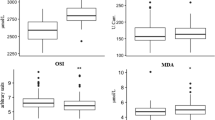Abstract
Oxidative stress develops when the generation of free radicals exceeds the antioxidant capacity of cells or extracellular fluids. It can also occur as a result of physical exercise, and the pathogenesis of exercise-induced myopathies and haemolysis in horses may be related to changes in lipid peroxidation caused by free radicals. Cells have developed biochemical protection against oxidative stress and, as tissues seem to increase their antioxidant defences under chronic activation, training may be one of the ways of increasing antioxidant defences. Accordingly, we tested some enzymatic antioxidant activities as well as nonenzymatic antioxidants in horses undergoing special training. The results indicated a decrease in both chemical and biochemical defences against free radicals during training. It was deduced that the horses' diet may have been unable to provide the increased need for antioxidant defences resulting from training.
Similar content being viewed by others
Abbreviations
- DPH:
-
1,6-diphenyl-1,3,5-hexatriene
- EU:
-
enzymic unit
- GSH-Px:
-
glutathione peroxidase
- P :
-
degree of fluorescence polarization
- Phospholipid P:
-
phosphorous content in phospholipids
- RBC:
-
red blood cell
- t-ButOOH:
-
t-butylhydroperoxide
References
Avellini, L., Spaterna, A., Reboldi, P. and Gaiti, A., 1993. Defence mechanisms against free radical-induced damages in sheep, cattle and dog erythrocytes.Comparative Biochemistry and Physiology,106B, 391–394
Barja De Quiroga, G., 1992. Brown fat thermogenesis and exercise: two examples of physiological oxidative stress?Free Radical Biology and Medicine,13, 325–340
Brady, P.S., Ku, P.K. and Ullrey, D.E., 1978. Lack of effect of selenium supplementation on the response of the equine erythrocyte glutathione system and plasma enzymes to exercise.Journal of Animal Science,47, 492–496
Chow, C.K., 1991. Vitamin E and oxidative stress.Free Radical Biology and Medicine,11, 215–232
Combs, G.F. Jr, and Combs, G.F., 1984. The nutritional biochemistry of selenium.Annual Review of Nutrition,26, 257–280
Deuticke, B., Heller, K.B. and Haest, C.W.M., 1986. Leak formation in human erythrocytes by the radical-forming oxidant t-butylhydroperoxide.Biochimica et Biophysica Acta,854, 169–183
Duthie, G.G., Robertson, J.D., Maughan, R.J. and Morrice, P.C., 1990. Blood antioxidant status and erythrocyte lipid peroxidation following distance running.Archives of Biochemistry and Biophysics,282, 78–83
Gatti, C., Noremberg, K., Brunetti, M., Teolato, S., Calderini, G. and Gaiti, A., 1986. Turnover of palmitic and arachidonic acids in the phospholipids from different brain areas of adult and aged rats.Neurochemical Research,11, 241–252
Haenen, G.R.M.M., Tsoi, J.N.L.T.T., Vermeulen, N.P.E., Timmerman, H. and Bast, A., 1987. 4-Hydroxy-2,3-trans-nonenal stimulates microsomal lipid peroxidation by reducing the glutathione-dependent protection.Archives of Biochemistry and Biophysics,259, 449–456
Kagan, V.E., 1988.Lipid peroxidation in biomembranes, (CRC Press, Boca Raton)
Kagan, V.E., Bakalova, R.A., Serbinova, E.E. and Stoytchev, T.S., 1990. Fluorescence measurements of incorporation and hydrolysis of tocopherol and tocopheryl esters in biomembranes.Methods in Enzymology,186, 355–367
Lentz, B.R., 1988. Membrane fluidity from fluorescent anisotropy measurements. In: L.M. Loew (ed.),Spectroscopic Membrane Probes (CRC Press, Boca Raton), 13–41
Litman, B.J. and Barenholz, Y., 1982. Fluorescent probe: diphenylhexatriene.Methods in Enzymology,81, 678–685
Machlin, L.J., 1980.Vitamin E, A Comprehensive Treatise, (Marcel Dekker, New York)
Martin-Rosset, W., 1990.L'alimentation des chevaux. (INRA Press, Paris)
Matsuki, N., Tamura, S., Ono, K., Watari, T., Goitsuka, R., Yamnobe, A., Hiraga, A., Kubo, K., Takagi, S. and Hasegawa, A., 1991. Exercise-induced phospholipid degradation in the equine skeletal muscle and erythrocytes.Journal of Veterinary Medical Sciences,53, 1001–1007
Ono, K., Inui, K., Hasegawa, T., Matsuki, N., Watanabe, H., Takagi, S., Hasegawa, A. and Tomoda, I., 1990. The change of antioxidative enzyme activities in equine erythrocytes following exercise.Japanese Journal of Veterinary Sciences,52, 759–765
Packer, L., 1984. Vitamin E, physical exercise and tissue damage in animals.Medical Biology,62, 105–109
Pigeolet, E. and Remacle, J., 1991. Susceptibility of glutathione peroxidase to proteolysis after oxidative alteration by peroxides and hydroxyl radicals.Free Radical Biology and Medicine,11, 191–195
Shanmugasundaram, K.R., Padmavathi, C., Acharya, S., Vidhyalakshmi, N. and Vijayan, V.K., 1992. Exercise-induced cholesterol depletion and Na+,K+-ATPase in human red cell membrane.Experimental Physiology,77, 933–936
Shinitzky, M. and Barenholz; Y., 1978. Fluidity parameters of lipid regions determined by fluorescence polarization.Biochimica et Biophysica Acta,515, 367–394
Wendel, A., 1981. Glutathione peroxidase.Methods in Enzymology,77, 325–333
Winterbourn, C.C., 1990. Oxidative reactions of haemoglobin.Methods in Enzymology,186, 265–272
Witt, E.H., Reznick, A.Z., Viguie, C.A., Stark Reed, P. and Paker, L., 1992. Exercise, oxidative damage and effect of antoxidant manipulation.Journal of Nutrition,122, 766–773
Author information
Authors and Affiliations
Rights and permissions
About this article
Cite this article
Avellini, L., Silvestrelli, M. & Gaiti, A. Training-induced modifications in some biochemical defences against free radicals in equine erythrocytes. Vet Res Commun 19, 179–184 (1995). https://doi.org/10.1007/BF01839296
Accepted:
Issue Date:
DOI: https://doi.org/10.1007/BF01839296




